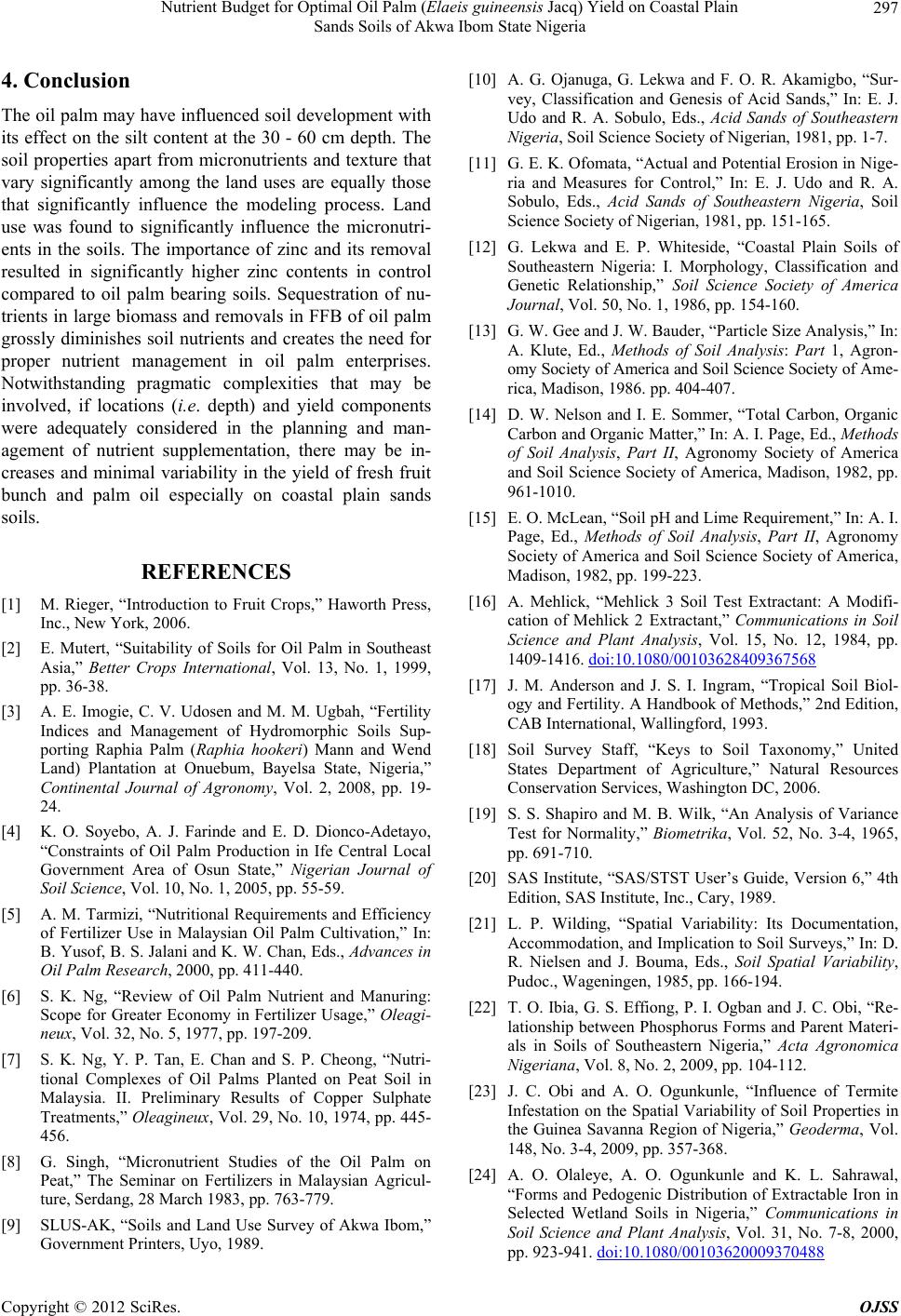
Nutrient Budget for Optimal Oil Palm (Elaeis guineensis Jacq) Yield on Coastal Plain
Sands Soils of Akwa Ibom State Nigeria
297
4. Conclusion
The oil palm may have influenced soil development with
its effect on the silt content at the 30 - 60 cm depth. The
soil properties apart from micronutrients and texture that
vary significantly among the land uses are equally those
that significantly influence the modeling process. Land
use was found to significantly influence the micronutri-
ents in the soils. The importance of zinc and its removal
resulted in significantly higher zinc contents in control
compared to oil palm bearing soils. Sequestration of nu-
trients in large biomass and removals in FFB of oil palm
grossly diminishes soil nutrients and creates the need for
proper nutrient management in oil palm enterprises.
Notwithstanding pragmatic complexities that may be
involved, if locations (i.e. depth) and yield components
were adequately considered in the planning and man-
agement of nutrient supplementation, there may be in-
creases and minimal variability in the yield of fresh fruit
bunch and palm oil especially on coastal plain sands
soils.
REFERENCES
[1] M. Rieger, “Introduction to Fruit Crops,” Haworth Press,
Inc., New York, 2006.
[2] E. Mutert, “Suitability of Soils for Oil Palm in Southeast
Asia,” Better Crops International, Vol. 13, No. 1, 1999,
pp. 36-38.
[3] A. E. Imogie, C. V. Udosen and M. M. Ugbah, “Fertility
Indices and Management of Hydromorphic Soils Sup-
porting Raphia Palm (Raphia hookeri) Mann and Wend
Land) Plantation at Onuebum, Bayelsa State, Nigeria,”
Continental Journal of Agronomy, Vol. 2, 2008, pp. 19-
24.
[4] K. O. Soyebo, A. J. Farinde and E. D. Dionco-Adetayo,
“Constraints of Oil Palm Production in Ife Central Local
Government Area of Osun State,” Nigerian Journal of
Soil Science, Vol. 10, No. 1, 2005, pp. 55-59.
[5] A. M. Tarmizi, “Nutritional Requirements and Efficiency
of Fertilizer Use in Malaysian Oil Palm Cultivation,” In:
B. Yusof, B. S. Jalani and K. W. Chan, Eds., Advances in
Oil Palm Research, 2000, pp. 411-440.
[6] S. K. Ng, “Review of Oil Palm Nutrient and Manuring:
Scope for Greater Economy in Fertilizer Usage,” Oleagi-
neux, Vol. 32, No. 5, 1977, pp. 197-209.
[7] S. K. Ng, Y. P. Tan, E. Chan and S. P. Cheong, “Nutri-
tional Complexes of Oil Palms Planted on Peat Soil in
Malaysia. II. Preliminary Results of Copper Sulphate
Treatments,” Oleagineux, Vol. 29, No. 10, 1974, pp. 445-
456.
[8] G. Singh, “Micronutrient Studies of the Oil Palm on
Peat,” The Seminar on Fertilizers in Malaysian Agricul-
ture, Serdang, 28 March 1983, pp. 763-779.
[9] SLUS-AK, “Soils and Land Use Survey of Akwa Ibom,”
Government Printers, Uyo, 1989.
[10] A. G. Ojanuga, G. Lekwa and F. O. R. Akamigbo, “Sur-
vey, Classification and Genesis of Acid Sands,” In: E. J.
Udo and R. A. Sobulo, Eds., Acid Sands of Southeastern
Nigeria, Soil Science Society of Nigerian, 1981, pp. 1-7.
[11] G. E. K. Ofomata, “Actual and Potential Erosion in Nige-
ria and Measures for Control,” In: E. J. Udo and R. A.
Sobulo, Eds., Acid Sands of Southeastern Nigeria, Soil
Science Society of Nigerian, 1981, pp. 151-165.
[12] G. Lekwa and E. P. Whiteside, “Coastal Plain Soils of
Southeastern Nigeria: I. Morphology, Classification and
Genetic Relationship,” Soil Science Society of America
Journal, Vol. 50, No. 1, 1986, pp. 154-160.
[13] G. W. Gee and J. W. Bauder, “Particle Size Analysis,” In:
A. Klute, Ed., Methods of Soil Analysis: Part 1, Agron-
omy Society of America and Soil Science Society of Ame-
rica, Madison, 1986. pp. 404-407.
[14] D. W. Nelson and I. E. Sommer, “Total Carbon, Organic
Carbon and Organic Matter,” In: A. I. Page, Ed., Methods
of Soil Analysis, Part II, Agronomy Society of America
and Soil Science Society of America, Madison, 1982, pp.
961-1010.
[15] E. O. McLean, “Soil pH and Lime Requirement,” In: A. I.
Page, Ed., Methods of Soil Analysis, Part II, Agronomy
Society of America and Soil Science Society of America,
Madison, 1982, pp. 199-223.
[16] A. Mehlick, “Mehlick 3 Soil Test Extractant: A Modifi-
cation of Mehlick 2 Extractant,” Communications in Soil
Science and Plant Analysis, Vol. 15, No. 12, 1984, pp.
1409-1416. doi:10.1080/00103628409367568
[17] J. M. Anderson and J. S. I. Ingram, “Tropical Soil Biol-
ogy and Fertility. A Handbook of Methods,” 2nd Edition,
CAB International, Wallingford, 1993.
[18] Soil Survey Staff, “Keys to Soil Taxonomy,” United
States Department of Agriculture,” Natural Resources
Conservation Services, Washington DC, 2006.
[19] S. S. Shapiro and M. B. Wilk, “An Analysis of Variance
Test for Normality,” Biometrika, Vol. 52, No. 3-4, 1965,
pp. 691-710.
[20] SAS Institute, “SAS/STST User’s Guide, Version 6,” 4th
Edition, SAS Institute, Inc., Cary, 1989.
[21] L. P. Wilding, “Spatial Variability: Its Documentation,
Accommodation, and Implication to Soil Surveys,” In: D.
R. Nielsen and J. Bouma, Eds., Soil Spatial Variability,
Pudoc., Wageningen, 1985, pp. 166-194.
[22] T. O. Ibia, G. S. Effiong, P. I. Ogban and J. C. Obi, “Re-
lationship between Phosphorus Forms and Parent Materi-
als in Soils of Southeastern Nigeria,” Acta Agronomica
Nigeriana, Vol. 8, No. 2, 2009, pp. 104-112.
[23] J. C. Obi and A. O. Ogunkunle, “Influence of Termite
Infestation on the Spatial Variability of Soil Properties in
the Guinea Savanna Region of Nigeria,” Geoderma, Vol.
148, No. 3-4, 2009, pp. 357-368.
[24] A. O. Olaleye, A. O. Ogunkunle and K. L. Sahrawal,
“Forms and Pedogenic Distribution of Extractable Iron in
Selected Wetland Soils in Nigeria,” Communications in
Soil Science and Plant Analysis, Vol. 31, No. 7-8, 2000,
pp. 923-941. doi:10.1080/00103620009370488
Copyright © 2012 SciRes. OJSS